
In 1984, Six Flags installed Roaring Rapids on the old location of the Traffique Jam, an Arrow car ride. The course has a lot more curves and winds through the forest a lot more than the previous Six Flags installations. This was necessary to fit the unique space requirements and in the same optic, the boat storage/maintenance area is immediately to the right after the rafts leave the loading turntable. Picture appears courtesy of http://www.negative-g.com/
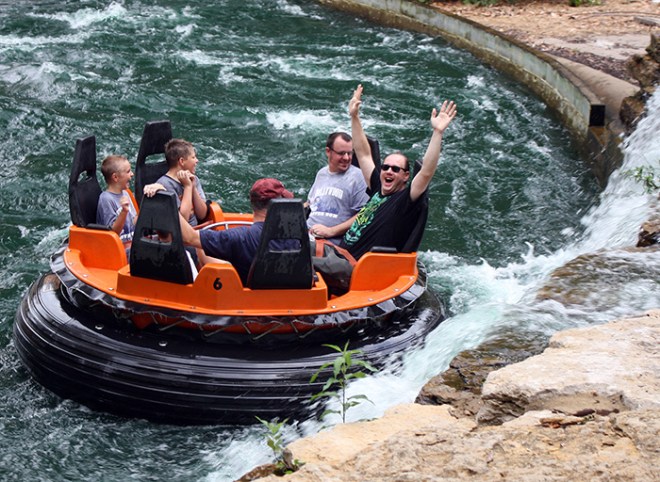
Fury of the Nile also opened in 1984 at Worlds of Fun (Kansas City, MO). The name was selected to fit the park theme at the time, which were areas named to Jules Verne “Around the World in 80 days”. The ride concludes with a long tunnel and various Egyptian symbols and characters were painted inside. The ride utilize a turntable for loading and this was the first river rapid attraction where the raft storage is the outer ring of the turntable. This picture appears courtesy of http://www.negative-g.com/.
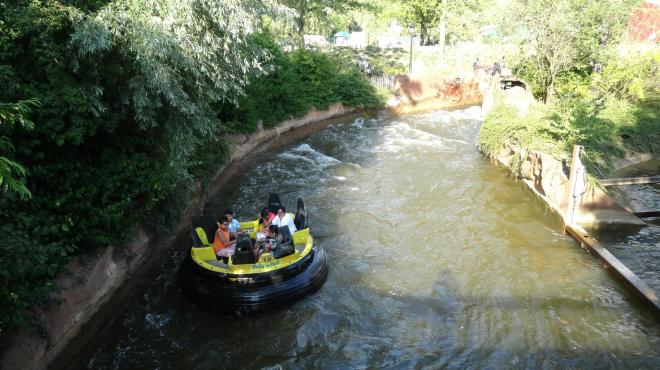
Donner Fluss opened in 1984 as well at Holiday Park (Hassloch, Germany). This was a bold move as the park was still quite small at the time and this was a major leap forward for them. This was the first River Rapids attraction in Germany. Picture appears courtesy of Flex.
In 1985, Intamin tried resolving the space issue by installing a small compact river rapid on a pier in Wildwood, NJ. It was called the Rampaging Rapids at first when it was Hunt’s Pier and then was renamed to Raptor Rapids and repainted under the Dinosaur Beach administration that lasted from 1996 to 1998. The ride then closed and was sold to a park developer in California that unfortunately never built his park and the ride is now presumed to have been scrapped and lost.
What made the boats very unique is that unlike every other rapids ride in existence, guests sat facing outward in individual seats around the ring. But, as Intamin pointed out after, the ride did not make sense: it cost nearly as much to construct and was as expensive to run as an Intamin 6 river rapid ride, so why bother to get 33% less capacity? Parks agreed and Rampaging Rapids remained a unique ride.
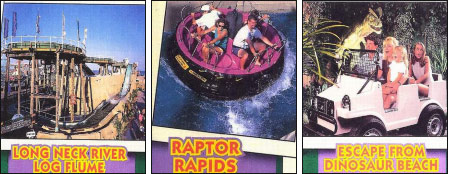
We discovered this postal card from the Dinosaur Beach era and you can see the unique purple boat in the middle.
1985 saw Kennywood (West Mifflin, PA) retiring one of their classic wooden roller coaster and the replacement was very successful: Raging Rapids. Dipper was a beautiful family wooden roller coaster, but it was the smallest in the park and the park was in need of a new water ride. Kennywood has a unique layout and the Dipper land was perfect for a new River Rapids attraction. The ride was quite successful, but like many parks, the wave maker was deactivated and guard rails installed in the pool. The ride has a beautiful setting and the exit platform has a great view of the ride.

This is the lift exit and you can see where the boats would enter the storage area. The conveyor belt on the right can slide over and take boats to storage.

The loading turntable. Intamin was brilliant in that in addition to the rotating turntable, you can see the conveyor belts on the outside. Those rotate at the same speed as the table and this give stable rafts that can’t move during loading. Some parks even automated the first set of conveyor belts so it acts as “sorter”. The Sorter purpose is to help rotate the raft so that one opening is always facing the turntable for safer passenger travel in and out.
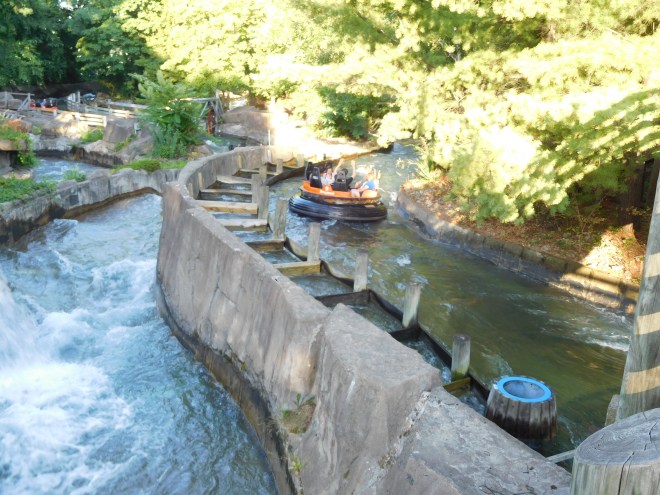
One thing that is hard to understand for many is that most river rapids installations have only one set of pumps: at the highest point of the ride. You can see in this picture the right path, which is visibly higher than the left one which is later in the course. A huge challenge in designing those rides is making sure the slope is angled so that the boats don’t go too fast or so slow they get stranded. In the original installation, the pools with wave makers and whirlpools helped keep the boats moving, but parks discovered that in many cases, they were not necessary.
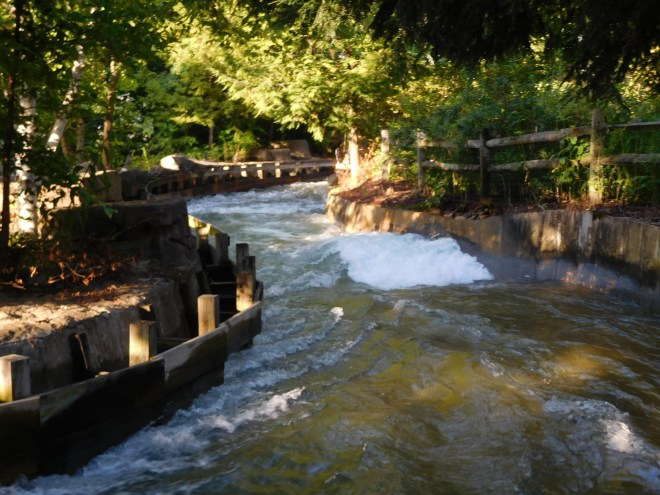
When you see white bubbles… get ready to get soaked! This is a good sign of a good rapid dip that will soak the boat.
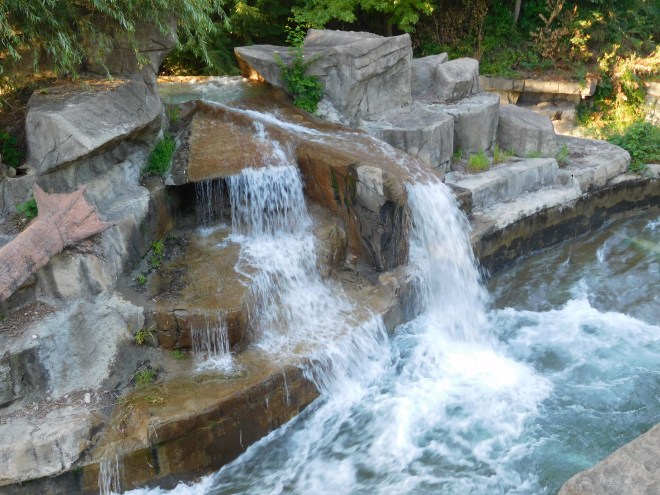
Halfway through the ride, the boat will navigate under this waterfall.

As you can see, the first waterfall was designed to dump its content right on the raft. Notice that this is yet another park that replaced the original headrests with the Hopkins ones.
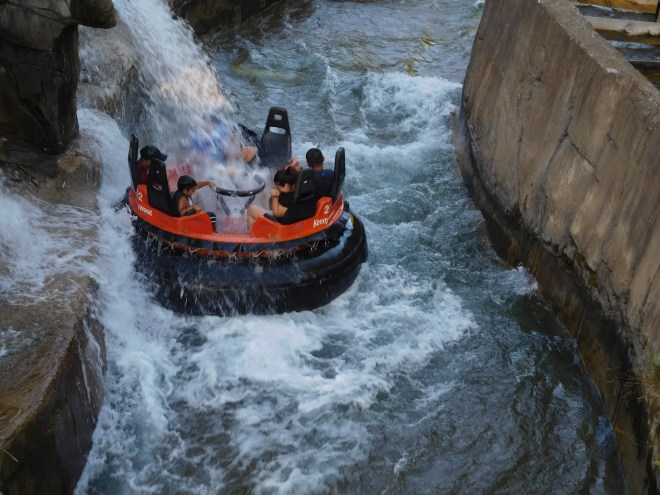
Another waterfall picture and you can see this boat has the original headrests.
In 1986, Charlie Wood took a look at what was going on around the world and he saw the future: river rapids attractions. He took a look at his property and he noticed that land in the back had the perfect gentle slope for the ride. This would help expand his park and give it an edge that no other parks within a 4 hours drive had. La Ronde (Montreal, 3 hours north) was busy building a wooden roller coaster, Darien Lake (near Buffalo, NY) 4 hours west had just opened a huge looping coaster and Riverside (Agawam, MA) two hours away had not yet built one. The timing was perfect and construction soon started on the Raging River.
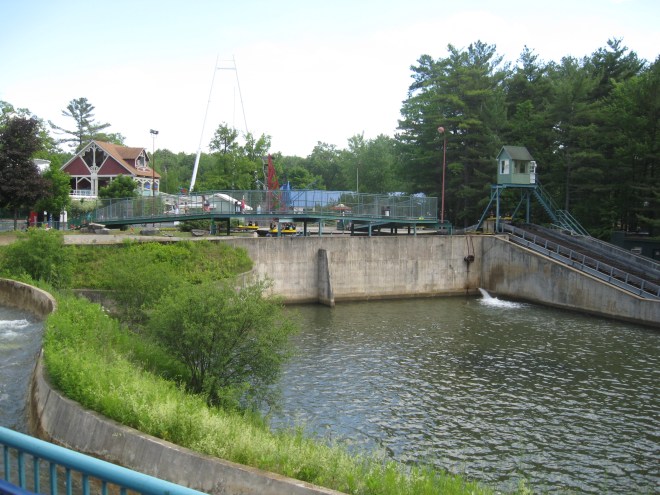
Construction is the biggest cost when building River Rapids attractions and you can see it in this picture. This huge reservoir had to be dug up so that the water in attraction has somewhere to go.
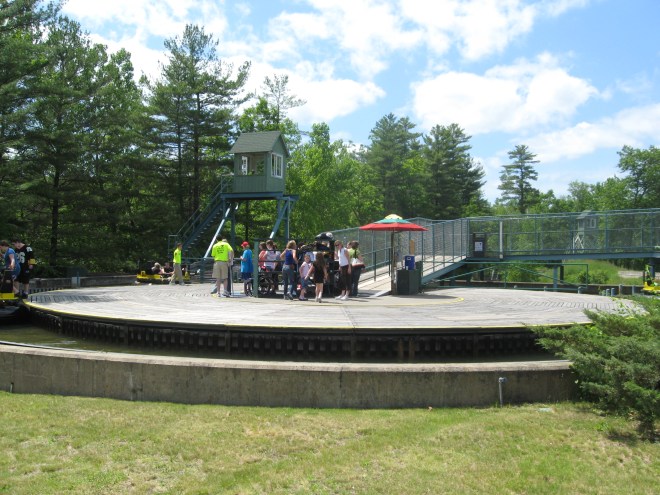
The loading turntable.
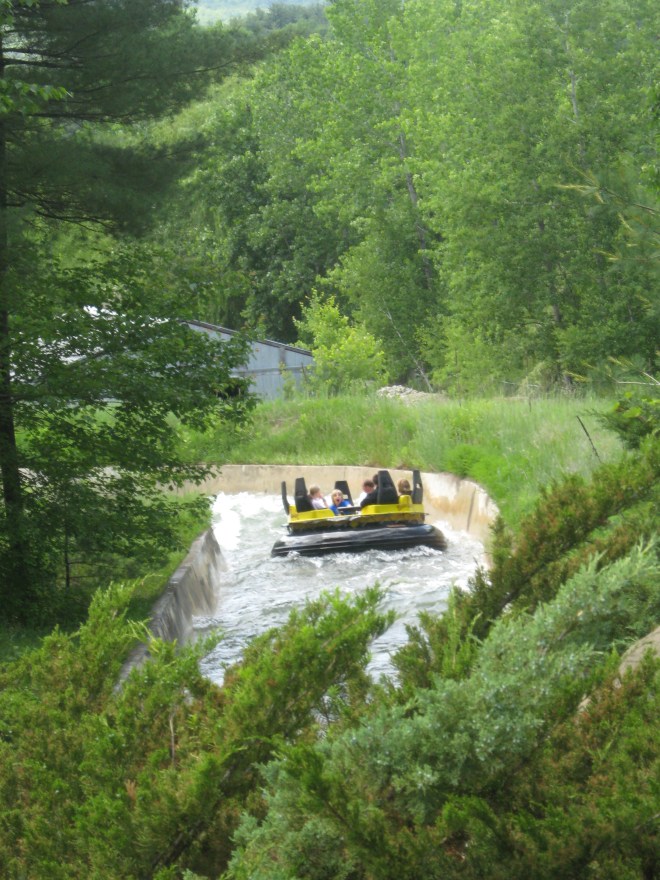
The very fast course take the rafts out back in the forest.
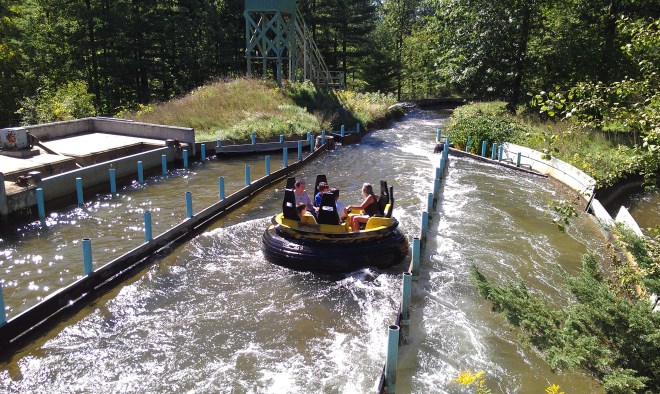
This was originally the location of the wave maker pool. When the ride originally opened, the operator in the tower you can see in the back would release rafts one by one and in the meantime, 2-3 boats would bounce around the pool in a random fashion. By the time Premier Parks purchased the park in 1996, the guardrails had been installed and the wave maker deactivated. This pool also feed the pass-through waterfall.

A close-up of the wave maker.
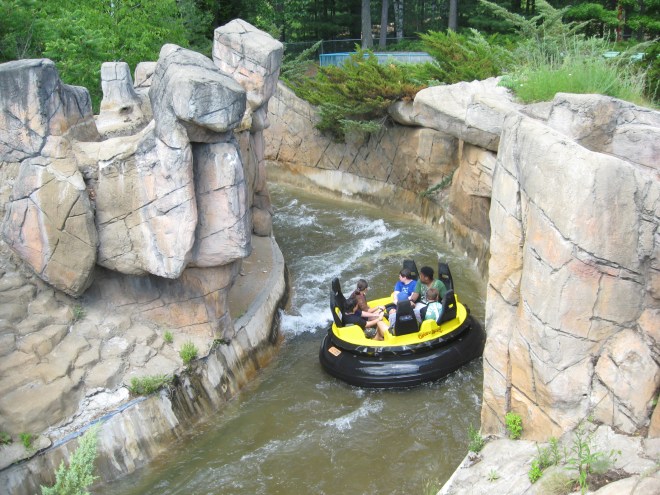
This canyon was originally the location of waterfalls, but the pumps broke down years ago and they were never fixed sadly.

The same area…. Dry. This was taken a day when the ride was receiving maintenance and we would like to point your attention to two things: the grate is where the pumps for the waterfall would collect water from the river and the pipe at the bottom creates a bumpy section of water.
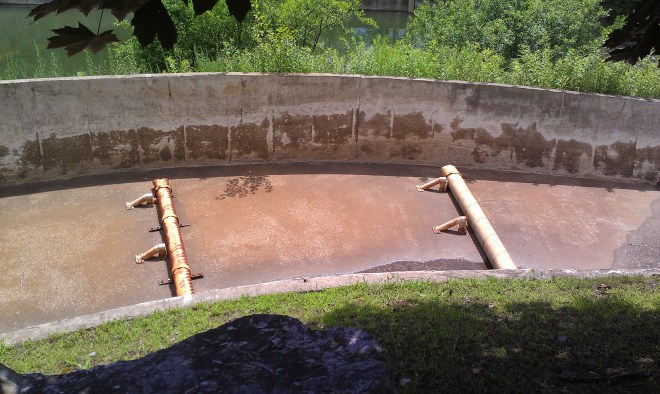
Corrugated steel pipes were selected to serve as obstacles in the water and to create the rapids.
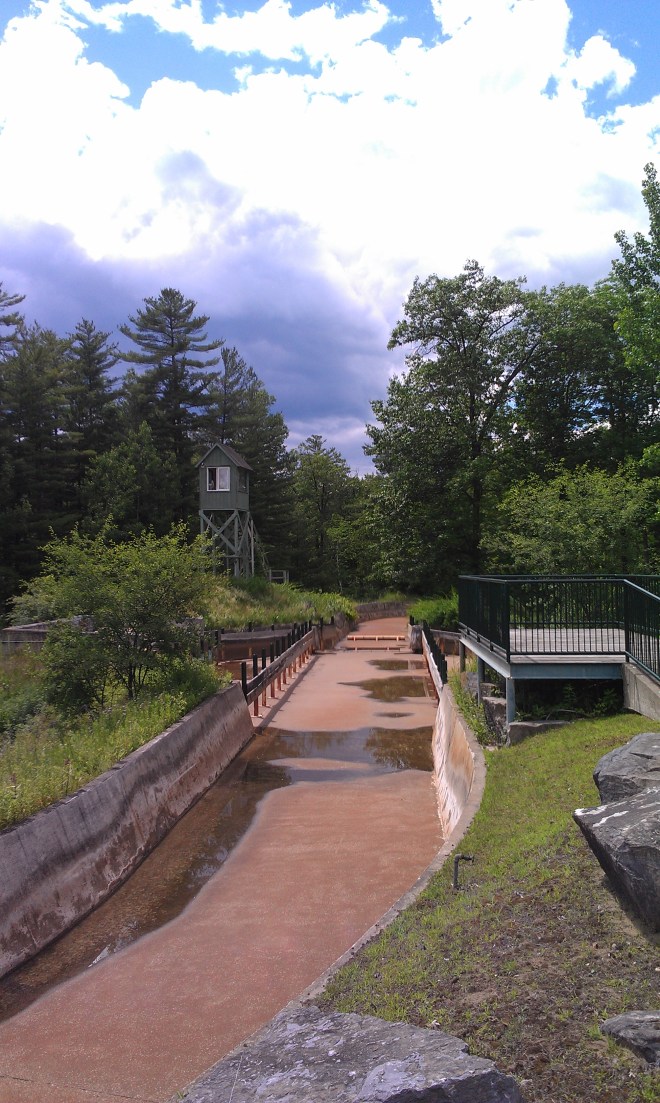
Another shot of the dry course.
